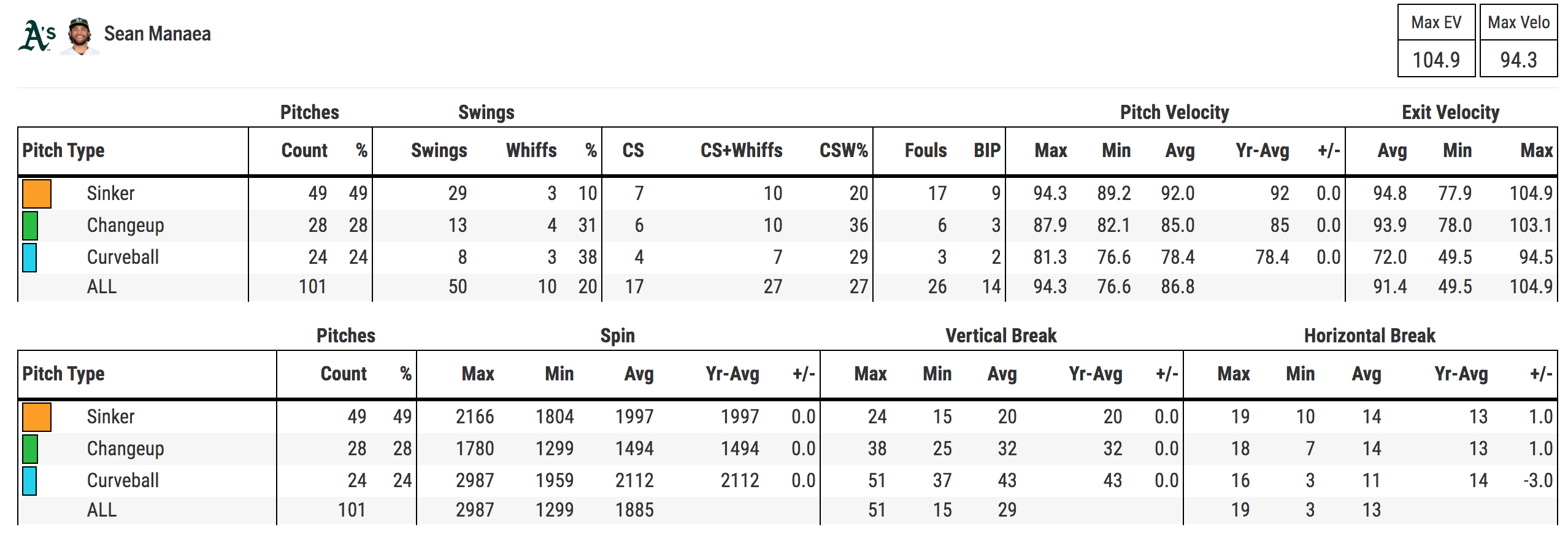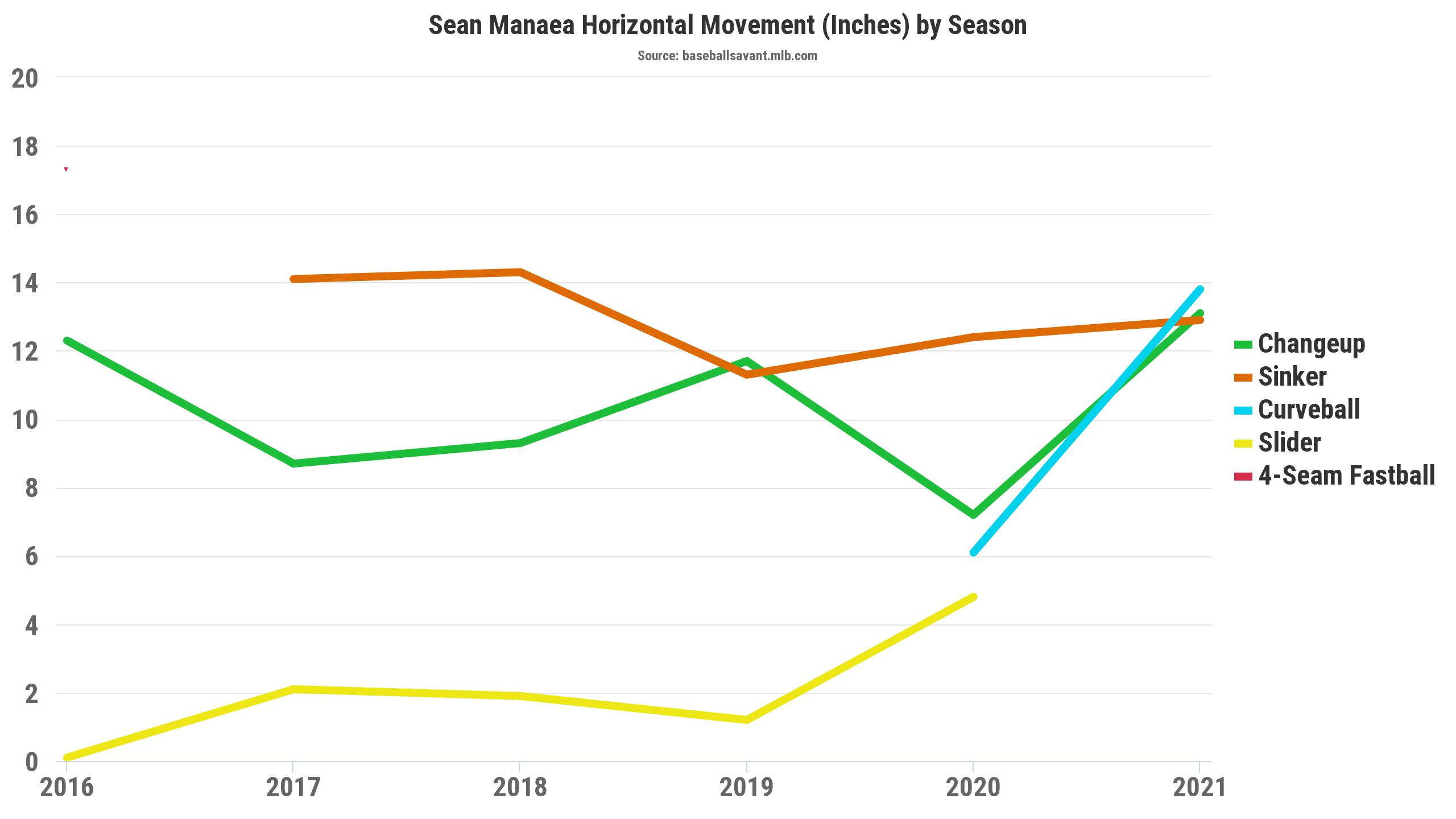Watching Sean Manaea’s start on Sunday, I felt giddy that velocity had come back as he sat comfortably at 92 miles per hour. His velocity was no guarantee after pitching through chronic shoulder impingements in 2017 and 2018, as he suffered a significant drop in fastball velocity and required shoulder surgery on his pitching arm. After missing the final month of 2018 and most of 2019, Manaea roared back with a 1.21 ERA across five starts, still using an underwhelming fastball, and became Oakland’s starter in the Wild Card game against Tampa Bay. Even though that start wasn’t what he nor the A’s wanted, it was great to see Manaea come all the way back after succumbing to such an injury. Last season, the left-hander continued to build on his velocity and pitched well down the stretch for a second consecutive year, once again making him a notable name in Oakland’s rotation. As we settle into the 2021 campaign, we’ll recap Sunday’s start and what we can expect from Manaea going forward.
A Recap Of Manaea’s 2021 Debut
After losing three straight games to Houston to open the year, the A’s looked to Manaea to stop the bleeding and avoid being swept. That effort fell short, as the left-hander gave up five earned runs in four and two-thirds innings, throwing 101 pitches.
To best break down this outing, we’ll be going pitch by pitch.
As previously mentioned, Manaea was finally able to recover some of the velocity that he once had, averaging 92 MPH. Despite the velocity gain, the left-hander only registered a 20% CSW on 49 thrown, with three measly whiffs on 29 swings — not great.
Now, there are a couple of things worth noting. The first is what it’s like to face Manaea. The fastball’s release point itself is unique since the pitch is thrown at 3.41 feet to the left — the second widest horizontal release point by a southpaw in the Statcast era — and 5.49 feet tall. Simply, Manaea releases the ball similarly to Chris Sale (3.12 ft left, 5.31 ft) and Jake Diekman (3.96 ft left, 5.41 ft). When you then consider that he (6.6 ft, but an elite 7.2 ft in 2020/21) has greater extension — which gives him a greater perceived velocity boost — than Sale (5.9 ft) or Diekman (6.1 ft), it’s quite easy to get excited about Manaea when he’s got such a release point while getting such great extension — now armed with improved velocity, how does he not get more whiffs?
Which is where we reach our next point. Manaea once again stayed low in the strike zone, like he’s done in years past. Look at the home runs given up on fastballs to Kyle Tucker and Jason Castro.
While the pitch to Castro was slightly elevated — around belt high — we can see the catcher (Aramís García) setting low targets on both of these fastballs. The question is why? Well, let’s see how Manaea’s fastball has traditionally fared. (Note: Baseball Savant has this classified as a sinker the past couple of seasons but Brooks Baseball and Fangraphs call it a Four-Seamer. For this article, I’ll refer to the fastball as a Four-Seamer).
| Year | Usage | Velocity | Spin Rate | Bauer Unit (BU) | SwStr% | wOBA | xwOBA |
|---|---|---|---|---|---|---|---|
| 2016 | 58.10% | 93.1 | 2000 | 21.48 | 6.20% | 0.375 | 0.374 |
| 2017 | 58.40% | 91.9 | 1976 | 21.50 | 6.70% | 0.357 | 0.363 |
| 2018 | 56.10% | 90.6 | 1983 | 21.89 | 6.30% | 0.306 | 0.349 |
| 2019 | 63.50% | 89.9 | 1956 | 21.76 | 9.20% | 0.220 | 0.336 |
| 2020 | 54.30% | 90.5 | 1879 | 20.76 | 5.20% | 0.334 | 0.335 |
Now, let’s see how often those pitches were used up in the zone.
| Year | Upper-Third% | SwStr% |
|---|---|---|
| 2016 | 19.10% | 17.20% |
| 2017 | 17.40% | 15.50% |
| 2018 | 17.30% | 14.90% |
| 2019 | 19.50% | 16.40% |
| 2020 | 13.40% | 13.60% |
What’s interesting here is that Manaea undoubtedly had a ton of success living at the top of the zone in 2019 and used it frequently, but in 2016 did not enjoy the same results. It seems likely that Manaea was burned more often in the lower parts of the zone in ’16 than in ’19 on the fastball, which produced the drastic difference in wOBA, but looking at how he did so well with his swinging strike rate overall in 2019, it would be best advised for him to keep living up in the zone going forward.
With the changeup, Manaea was as superb as ever, with a 36% CSW and four whiffs on 13 swings. Of course, that’s no surprise as it’s consistently been his best offering ever since he changed his grip from a circle change to a split back in 2016.
https://twitter.com/enosarris/status/736378778683768835?s=20
When changing grips, Manaea was able to gain more control while also deadening the ball by generating less backspin — therefore, less vertical movement hence more drop — and a slight ‘cut’ since there is more pressure on the outside of the ball. With control and good movement, you can see hitters look foolish often, as Alex Bregman did here:
The last pitch we have is the slider. The returns were decent (29% CSW) as he was able to generate three whiffs on eight swings. However, I am still excited about the pitch. Before I explain, it’s important to know how far this pitch has come.
For years, Manaea’s breaker has been slow — around 78 MPH — and really didn’t move all that much.
Manaea wanted the pitch to be quicker to better tunnel with his heater, but it always felt uncomfortable when trying to do it. After being shown a grip from A’s pitching coach Scott Emerson resembling that of a cutter, he was able to hit 85 MPH in a Spring Training game last year and that’s likely what registered a few times on Baseball Savant as a slider (.177 wOBA, 31.3% Whiff) a year ago. Considering Hall of Famer Randy Johnson worked with Manaea on the slider at that same time and Johnson’s was more in the mid-80’s on the radar gun, I’m surprised the pitch didn’t stick.
Manaea’s traditional slider is what’s called a curveball (.455 wOBA, 24.5% Whiff) in the same database, and that pitch lacked success, to say the least. But there is an interesting nugget on display here:
As you can see with the ‘curveball’, Manaea reached 6.1 inches of horizontal movement last season, which was much greater than the slider of years prior, which sat around an inch of H-movement.
In Sunday’s outing, Manaea was able to double the H-movement of last season, moving the ball a whopping 13.8 inches horizontally. This is where we can bring back Sale, whose slider registered 14 inches of horizontal movement back in 2019. Better yet, the speeds are similar, as Sale threw his at 79 MPH two years ago.
In this comparison, we can now use it to hypothesize an approach that will generate more strikeouts — what better way to do it than to use one of the best strikeout pitchers to ever step foot on the mound?
Since Sale uses his fastball predominantly up and middle-in to right-handed batters, given its great spin, he can then tunnel his slider off the plate glove-side to get swings and misses or get called strikes arm-side to freeze either left-handed or right-handed hitters.
Now, Sale (49.8 in. with gravity) does get greater downward movement than Manaea (43.3 in. with gravity), but if the latter starts to regularly use his four-seamer in a similar fashion — again, we’re emphasizing elevated heaters — he can get more whiffs like this one to Carlos Correa.
Expectations
After all the hard work post-surgery, Manaea now possesses a more lethal arsenal than he’s ever had before, putting him on a path to greater heights. But with new stuff comes a new learning curve, where the southpaw could struggle with walks, like Yusei Kikuchi did with his reworked fastball a year ago. Compounding with the potential issue of walks, if Manaea does not throw the fastball up in the zone as he did in 2019, he’ll continue to be hit hard and gain few whiffs like he did Sunday, while also giving his slider less of an opportunity to tunnel with it. Hopefully, we can see everything click before the year is done, but it’s going to take time; with his history to date, I’d expect Manaea to succeed, which will absolutely be worth seeing.
Photo by Leslie Plaza Johnson/Icon Sportswire | Design by Quincey Dong (@threerundong on Twitter)




This is super deep and super cool analysis! After a few more starts, which i haven’t been able to analyze myself, how do you feel about his pitches and strategy?
Thanks for the kind words, Mario! Sorry for the late response, but I’ve been impressed with the way Manaea has worked his fastball up in the zone in the past three starts since I wrote the piece. Against the Twins, he was excellent with his command up with the fastball and the results followed. On Monday, Manaea wasn’t quite as sharp with his fastball but was able to rely more heavily on his curveball, which performed admirably (44% CSW), which is nice to see given the new movement it has this season. I thought both of these would take longer than three starts, but I’m glad I’m wrong!